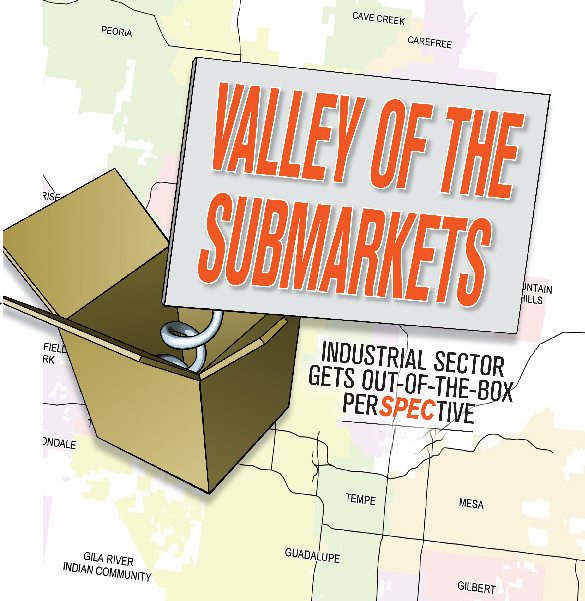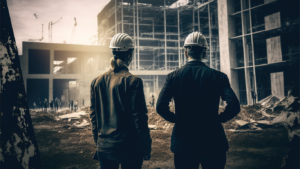Jeff Hays, senior vice president of sales and leasing at Commercial Properties Inc., is starting his 30th year specializing in the industrial sector and will be the first to tell you that everybody’s busy and no one’s complaining.
LGE Design Build has 54 industrial projects either in the ground or in design, says President Dave Sellers. Brock Grayson, vice president of Layton Construction and co-chair of GPEC’s Community Building Consortium, shares the same sentiments with Layton’s 650KSF of build-to-suit and expansion projects in Arizona.
While LGE’s sweet spot, says Sellers, includes many manufacturing buildings and design-build projects for companies that won’t fit into a spec space, spec isn’t dead. About five spec industrial buildings are in the planning or permitting process. From Sellers’ perspective, the sector is suiting up, so to speak. In the last two months, Sellers says, LGE Design Build has received seven new build-to-suit projects. Layton Construction has also seen some build-to-suit demand. The rise in these projects for Layton has little to do with a declining interest in spec development, says Grayson and Layton Executive Vice President Andrew Geier. They’re just keeping busy with everything else.

Between the build-to-suits and the spec development, though, are the empty spaces contributing to deceptively high vacancy rates. These are the semi-obsolete industrial buildings that need some tenant improvement or a functional change.
A lot of businesses need excess land for more parking or equipment or yard storage, he adds. “It has become a lot more difficult to find quality buildings. That’s leading to some build-to-suits,” he says.
CPI has worked on a handful of distribution center build-to-suits, including Barrel of Fun in Tolleson and Legends Furniture. Unlike office and retail, there’s less interest in aesthetics as much as functionality — clear heights, power capabilities and square-footage.
It’s one thing that’s keeping obsolete industrial spaces from becoming dysfunctional. It’s about $25 per square foot to raise a roof, for instance, so office users looking for that industrial feel are more likely to take the old 16-foot industrial space than someone who is looking for the new 36-foot clear heights. Users are safer bets (they’ll pay more), but Hays says CPI is seeing more action from investors lately, particularly with those in California.

MARKET UPDATE
While the rents seem to have stabilized overall and absorption in 2Q was 4MSF, things still aren’t where they were. But CPI’s Hays isn’t concerned as long as the market can reach a happy medium. More end-users are upsizing, build-to-suits are seeing success and quality buildings are becoming harder to find. The effect of rising construction costs depends on the submarket in which a developer is looking.

The airport, East Valley and Deer Valley submarkets are seeing upward pressure on rental rates due to short supply of industrial space. In turn, CBRE Senior Vice President of Industrial Services, Pat Feeney, says the short supply of investment properties are putting downward pressure on cap rates for leased investments. The lack of available land is another way Feeney says developers can combat rising construction rates.
“Those that are lucky enough to own in these submarkets are really in the driver’s seat when it comes to tenant negotiations,” Feeney says. On the other hand, he says, the Southwest Valley submarket is “lethargic.”

“The next couple of large square footage users that lease space are going to be treated as the belle of the ball,” Feeney says. “I think that today the landlords are financially sound so it is unlikely we will see lease rates drop to the levels we saw in 2009 when the market was similar in terms of supply.”
“If it’s at the right price, someone will take it,” says Hays, adding that many class-B and -C industrial was absorbed for other uses during the downturn. “People are still looking for good quality buildings.”
A lack of leased warehouse product in the Southwest Valley available to investors, despite high demand, keeps values up, Feeney says. “Currently, the big box distribution user activity and inquiries are at a high level, but users in this group have been very slow to commit to executing leases,” says Feeney.
“However, it should be noted that while large users have been hesitant to commit, the 20KSF to 100KSF users have been extremely active. Users in this size range have been carrying the market so far this year with more than 1.3MSF of positive net absorption in the first half of 2014.
I believe that as soon as we see five to six large leases signed in the Southwest Valley big box distribution market, we will reach a balance of supply and demand that we have not seen since 2005 and 2006. I am very encouraged with the current condition of the market.” When big box distribution sees some absorption, he says, overall vacancy stands a chance at single digits.




